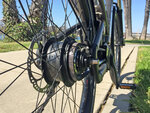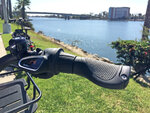While visiting Propel Bikes, in Long Beach, California, for some Riese & Müller reviews, I had an opportunity to dig into the Rohloff E-14 as well as the updated Enviolo N380SE. These two hub drivetrains allow for shifting at standstill, they tend to be more durable than a traditional cassette + derailleur, and they are starting to popup on more ebikes and bike share programs. This is especially true for the Enviolo N330 model, which is also appearing on the Moustache Lundi value model. The following video and specs come from my own research, input from Chris Nolte, and some conversations with Avelino Rivera of Fallbrook Technologies (Enviolo/NuVinci) who is a Business Development Lead for North America and Bikeshare Globally.
The big takeaways for me are that this is a stepless system that can be adjusted while pedaling or at standstill. The NuVinci optimized products are labeled as Continuously Variable Planetary hub systems (CVP) but also sometimes referred to as Continuously Variable Transmission. It's the same sort of technology used on the Toyota Prius, to optimize motor RPM and reduce energy loss and transmission wear compared to set gears. Here are a few more interesting takeaways from the research we did:
The big takeaways for me are that this is a stepless system that can be adjusted while pedaling or at standstill. The NuVinci optimized products are labeled as Continuously Variable Planetary hub systems (CVP) but also sometimes referred to as Continuously Variable Transmission. It's the same sort of technology used on the Toyota Prius, to optimize motor RPM and reduce energy loss and transmission wear compared to set gears. Here are a few more interesting takeaways from the research we did:
- The Enviolo name is a modification of the root acronym NVO, which stands for "NuVinci Optimized" and thus, almost makes the name recursive. Fallbrook Technologies is the parent company here, and as they applied the NuVinci technologies to more applications and really started focusing on bicycles and electric bikes, they began calling it NuVinci Cycling but then moved to a new more unique name to apply specifically to the cycling space, and that is how we got Enviolo.
- As a planetary system, the insides of an Enviolo hub include spheres that orbit the center axle. The system is not being produced in 135mm hub spacing with a 10mm threaded axle for the standard N330, N360, and N380 products as well as 135mm, 142mm, and 148mm hub spacing with a 10mm threaded axle for the N380SE (Special Edition) to be used with wider dropouts and Boost hub spacing.
- The SE model offers wider hub spacing options as well as a higher torque rating of 100 newton meters continuously and up to 120nm peak. It's a product that targets sportive and cargo bike applications and is well-suited to the Bosch Performance Line CX motor, which produces up to 75 newton meters of torque.
- Enviolo has moved towards an all-black look with their hub and shifting mechanism, the older NuVinci shifter was called the Nfinity C8 and had a silver casing.
- The weight of traditional cassette + derailleur is usually somewhere between 1lb-2lbs while the Rohloff Speedhub is roughly 4lbs (1,820 grams) and the Enviolo N380 is roughly 5.5lbs (2,400 grams). Part of what contributes to this weight is a special traction fluid inside, made by Valvoline.
- Sometimes, the Enviolo NuVinci system can feel sluggish or soft when pedaling and I've been told that there is a break-in period of ~500 miles where it may not be operating at optimal efficiency... but the addition of traction fluid and the orb pivot system vs. gears just isn't as crisp and quick as a derailleur + cassette or most planetary geared hubs.
- Maintenance on the Enviolo NuVinci optimized hubs for bikes appears to be very low. There is no specified maintenance interval for this product, vs. the Rohloff Speedhub which recommends changing the oil every year or so depending on use. There is no bleed valve on a NuVinci hub for owner servicing. The most vulnerable and wearable parts on the system appear to be the shifting mechanism and two cables that are utilized in changing gear ratios. The Harmony and HSYNC electronically shifted NuVinci products probably require even less maintenance, aside from battery care, because they use much shorter shifter cables and only a single electronic wire.
- Part of what makes these systems so tough, especially the mechanically shifted Enviolo, is that there's no derailleur hanging down off of the side. If the frame gets banged into a rack or pole, or maybe the bike tips over, the drivetrain won't get damaged or go out of tune as easily.
- The Enviolo product comes in a mechanical version (with two cables/wires that you physically move when you twist the shifter), a Harmony version (which relies on an independent power source and proprietary shifter), and an HSYNC version (which integrates with electric bike systems from Panasonic or Bosch, to utilize their battery, display, and button pad).
- With Bosch implementations of HSYNC, an additional level of shifting optimization is introduced through eShift. In short, the Bosch motor controller listens for shifting signals that are triggered whenever you change gears, and the motor backs off to allow for smoother gear ratio changes.
- Chris talked about a hardware project between Continental and NuVinci which would integrate the continuously variable transmission into a mid-drive motor. I haven't seen or tried this system, but it sounds neat.
- Right now, The Enviolo product is focused on five categories of bikes including: City, Trekking, Bike Share & Business to Business, Cargo, and Sportive
- Drive systems that have been using the HSYNC product include Bosch and Panasonic. Companies that have been selling in on their ebikes include Flyer, Tempo, Piaggio, and Butchers & Bicycles. I was told that HSYNC uses the CAN bus protocol to interact with drive systems and may feature heart rate optimized shifting in some situations in the future. I personally am wondering if we will see this from Bosch with their new Bluetooth compatible Kiox display panel.
- Some companies, like Riese & Müller have opted for the mechanical shifting system only, because it performs in a sporty way that accommodates advanced riders. It may also save weight and cost.
- It sounds like the Enviolo mechanical shifting systems may be available aftermarket, through select dealers. The cost for hardware is likely in the $500 range but service and installation could get expensive because the hub has to be spoked into a wheel to fit the size of your original bicycle. They use J&B imports as a distributor in North America.
- For those with wider axles, it looks like the Enviolo hub is compatible with dropout kits. these may allow it to work with a 12mm thru-axle setup but it may not work in the case of thru-axles because the original 10mm axle is fixed to the hub.
- One example of a bike share program that is using Enviolo NuVinci is Motivate, which was recently purchased by Lyft. It sounds like they paid $250M to become America's largest bikeshare company. They will reportedly be using the Enviolo N330, more affordable and limited range CVT system. In related news, Uber reportedly spent $200 million on a bike share program called Jump.
- Other companies that use the Enviolo NuVinci CVP systems include Organic Transit, EVELO, Riese & Müller, Piaggio, Velec, eProdigy, Moustache, Corratec, Butchers & Bicycles, CUBE, Grace, Urban Arrow, Bodhi (no longer in business), Merida, Centurion, Pegasus, Hercules, Zemo, Sparta, Sinus, Felt, Trek, and KTM.
Attachments
Last edited:


